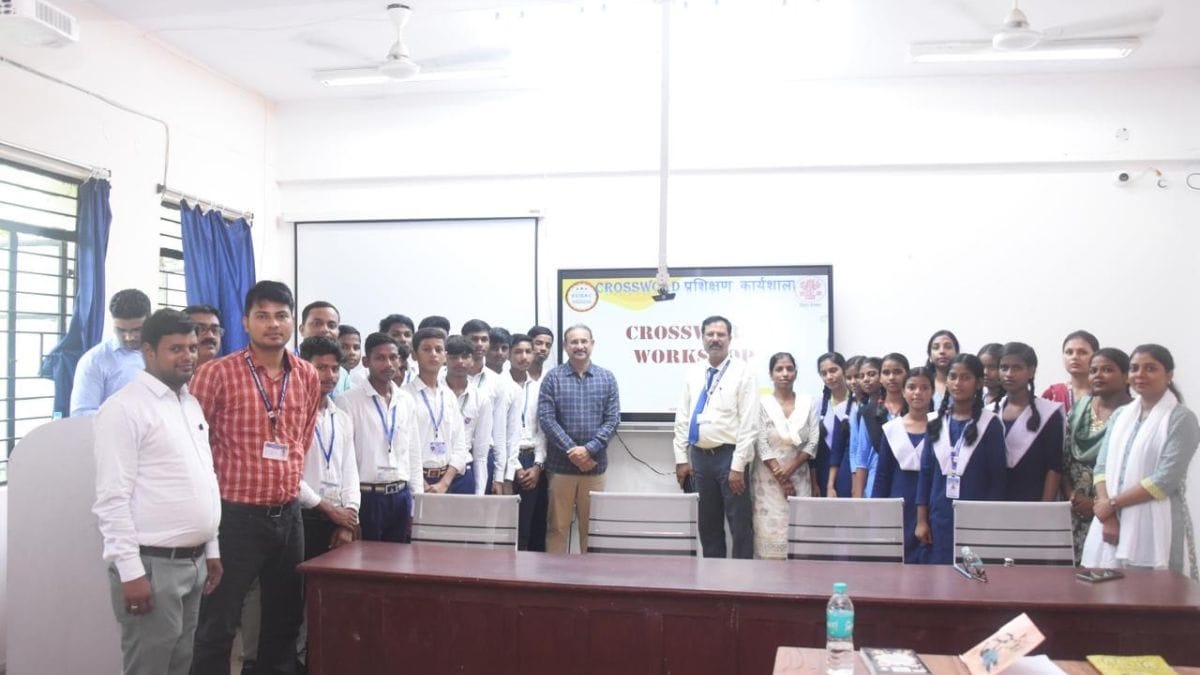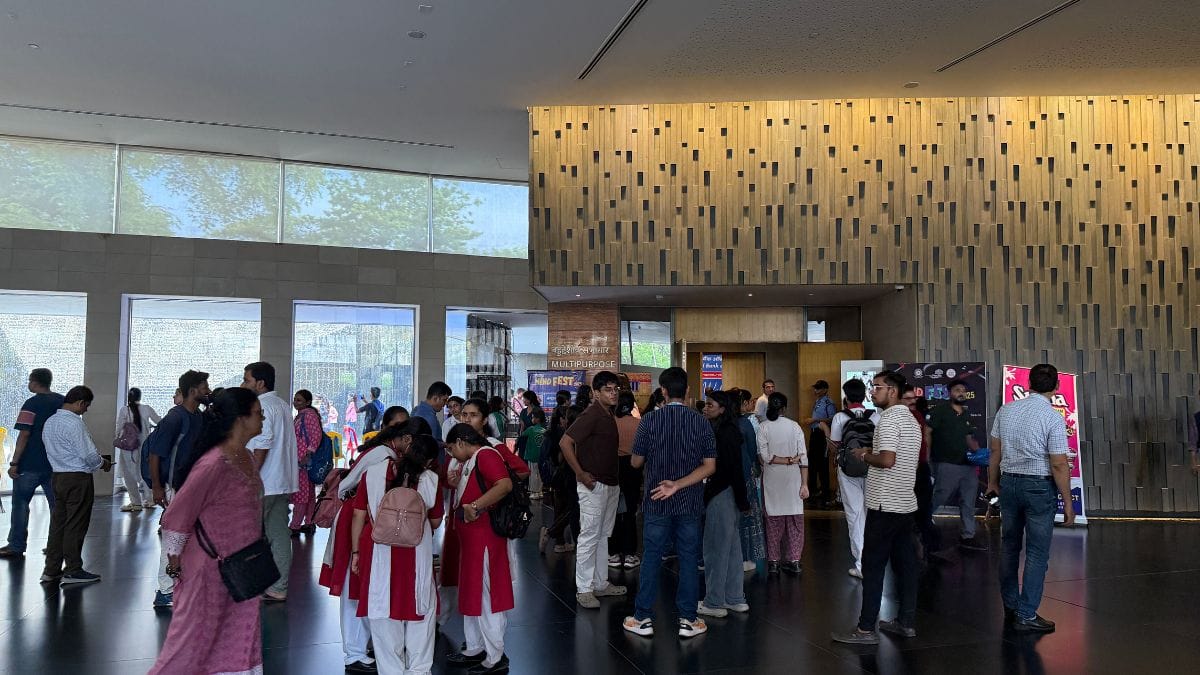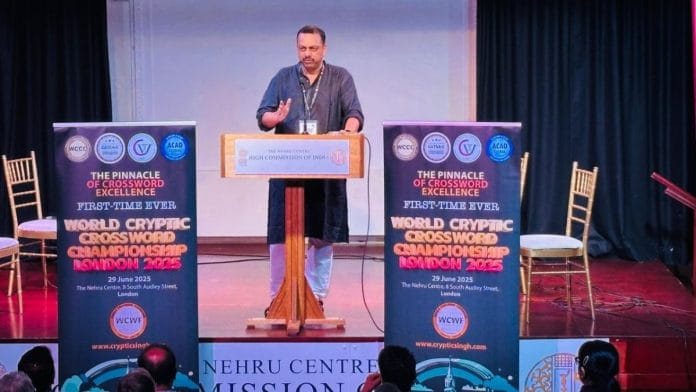Patna: There is a quiet revolution sweeping Bihar. Not caste but crossword.
And in June, it reached London. The World Cryptic Crossword Championship, set up by former IAS officer Vivek Singh, conducted its first global event at the Nehru Centre in London.
Singh’s obsession for the black-and-white grid was born during a university strike in the 1980s. More than 40 years later, the IAS who retired after serving as the development commissioner of the state has given Bihar one more thing to be proud of—and he isn’t citing a nugget of history but creating one.
“For two long years, the Delhi University Teachers’ Association (DUTA) and Delhi University Karamchari Union (DUKU) strikes in 1982-83 meant that our classes remained suspended for most of the time. That’s when I began solving The Times of India Sunday Crossword,” recalled Singh, a 1989 batch IAS officer of the Bihar cadre.
Today, at 60, Singh stands tall as a seasoned cruciverbalist, reimagining what crosswords can mean in Bihar and across India.
If you took a domestic flight in the ’90s and flipped through Swagat, the Indian Airlines magazine, and attempted the crossword mid-air, chances are, it was Singh who had set it. Later, in the 2000s, if you ever solved a Hindustan Times puzzle under the pseudonym “5151,” that was Singh again. The numbers when written in Roman and Hinglish would read ‘VIVEK’.
Today, the Ramjas graduate has become the ‘architect’ of India’s crossword movement. Till about a decade ago, it majorly remained a private pursuit. But when the world celebrated the centenary of crossword in 2013, Singh couldn’t stop himself from taking it to the public in a much bigger manner.
Then serving as Principal Secretary in Bihar’s Department of Environment and Forests, he launched the Indian Crossword League (IXL), a first-of-its-kind online contest for seasoned crossword enthusiasts, and CCCC (CBSE Cryptic Crossword Contest, a national-level inter-school championship.
“The response was overwhelming,” Singh told ThePrint.

With schools from other boards joining the contest, it was rechristened as National Inter-school Crossword Championship. However, they stayed with the original acronym, CCCC, for brand recognition and legacy.
In 2022, Singh added NICE (National Inter-College Crossword Expedition) to the growing number of crossword competitions across India.
Also read: Faridabad farmhouses vs Aravallis isn’t over. It’s a war that has just begun
How it spread into rural Bihar
Every afternoon, sharp at 3:35pm, a clue drops under the banner ACAD (A Clue A Day) on the website crypticsingh.com. It’s meant for school students to solve the crossword. The website was launched by Singh in 2013 to offer daily puzzles.
Just five minutes later, at 3:40pm, another clue pops up, this time a tougher puzzle meant for college-level solvers.
Across cities and villages, convent schools and government hostels, from London to Australia, people log in, at once. Among them is Tanya Kumari, 17, a Class XI science student at Ambedkar Girls Residential School in Patna’s Gai Ghat—home to 700 girls belonging to the Scheduled Caste and Scheduled Tribes from Classes I to XII.
“I probably first saw a crossword grid in Class IX, but there was no one around me who could explain how it worked,” said Kumari, the eldest daughter of Veer Chandra Ram, a daily wage labourer who makes Rs 500 a day at a construction site. That was two years ago. But a workshop organised by the SC-ST welfare department in 2023 changed it all.

Today, Kumari makes sure to attempt a crossword almost daily. And she is participating in contests—Mind Fest, CCCC and now the BSEB Crossword Competition 2025. Like Kumari, 29 other girl students from her school are also playing this game regularly.
Kumari’s English has improved and she holds a new confidence.
“It’s our life’s greatest achievement that you can speak English,” Kumari spoke to this reporter in English, expressing her mother’s feelings. The Class XI student is a resident of Bilandpur village in Vaishali district, 30 km away from Bihar’s capital Patna.
English has long acted as a gatekeeper for students from the Hindi heartland. Many remain fearful of the language itself. Crossword is slowly helping them bridge that gap.

As the vice president of the Crossword Association of Delhi and a seasoned mentor, Vinayak Ekbote, 58, has seen the curve Kumari has travelled when it comes to the language itself. He was among the experts who first conducted workshops at Tanya’s school.
“Students like Tanya were fearful of the language itself. Before, I could speak of clues or anagrams, like how Nepal could twist into ‘Plane’ or ‘Panel’ or ‘Penal’ or ‘Plena’, I had to confront their fear of English,” he said.
Tanya’s ability to speak the language with confidence is now a matter of equal pride for Dr. Birendra Kumar Binay too, the school’s principal, who joined in 2023.
“We’ve attached English teachers to the girls who play crosswords. It has transformed the culture of the entire school,” he said.
In schools, there was a vast, under-explored space for mindsports, and in an age increasingly dominated by social media and digital distractions, crosswords offered an intellectual alternative. Bihar’s SC-ST residential schools were tapped at the right time, as many of them are equipped with internet access, Wi-Fi, and libraries stocked with thousands of books. Tanya Kumari’s school, for instance, boasted a library with over 13,000 books.
Also read: Brand Bengaluru is stuck on bad roads. MNCs, startups are saying ‘Hello Hyderabad’ now
From a pilot project to a festival
Crossword competitions being conducted by Bihar have become a year-round carnival. Some months are reserved for registrations, followed by preliminary rounds, then city-level contests, and finally the grand finales in cities such as Bengaluru and Delhi. The epicentre remains Patna.
Singh has taken the crossword culture to Bihar’s villages, mobilising the SC-ST Welfare Department and the Department of Science and Technology while also securing patronage from premier institutions such as the IIMs and IITs.
Bihar has 38 engineering colleges and 46 government polytechnics, and the number of students registering for crosswords has surpassed 10,000, according to statistics from the Department of Science and Technology.
In 2023, the SC and ST Welfare Department, Bihar launched a pilot project across residential schools serving the community kids.
Out of 91 schools catering to more than 28,000 SC-ST children in Bihar, the pilot introduced crosswords in eight schools across various blocks.
Most schools and colleges didn’t quite know what to make of it. Teachers and principals stared at the black-and-white grid, unsure of what it was or how it worked. ‘Na dekha, na suna, na batane wala (Never saw, never heard of it, and no one informed us before)’—that was the standard response from principals and teachers.
The teams in science and technology and SC-ST welfare departments confronted challenges that weren’t about resources or infrastructure, but about the absence of role models among the hinterland students.

“To ease this out, in the second half of 2023, two students from each of the eight schools, studying in Classes VII, VIII and IX, were shortlisted from a larger pool,” said Sumit Sindhi, 36, an officer in the SC-ST Welfare Department.
“They were further trained and sent to various contests. We waited for them to win a competition before scaling up. Without any award, it would’ve been difficult. Crossword kya hota hai?” recalled Sindhi.
To monitor progress and sustain the enthusiasm, the department has also designated nodal officers at the district level to provide support.
In 2024, within a year of the Department’s involvement, teams from different district schools, some in the most remote areas, including in Kaimur, Motihari, Araria, participated in the CCCC 12.0 crossword contest. It was the 12th edition of the National Inter-School Cryptic Crossword Contest, meant for school students across India.
Their representation has led the state to scale the game more systematically. Crosswords are now part of the curriculum in 73 residential schools.
“For the longest time, it was perceived as something meant for convent or elite schools and we’ve been able to break that with some of the top solvers being from the remote government schools,” said Singh, adding that crosswords have now transcended the boundaries of DPS and St. Michael. The Bihar School Examination Board (BSEB) is also conducting a crossword competition this year in its schools.
Currently, registrations for the 13th edition of CCCC and the 4th edition of NICE are underway. The organisers have already registered over five lakh participants from thousands of schools across India.
“Just a decade ago, even a few thousand registrations had us on cloud nine. This is historic,” said Singh.
It’s not just the numbers that excite him, but also the transformation into a real-time, on-stage spectacle, with hundreds of solvers glued to the puzzle, eyebrows raised, and words dancing across the hall.
“I don’t see crosswords as just a pastime. They’re a spectator sport. I wouldn’t mind seeing them as part of the Olympics someday.”
Singh made this statement fresh off a recent milestone—having returned from London, where he successfully conducted the first-ever World Cryptic Crossword Championship (WCCC), convened at the Nehru Centre on 29 June.
The championship brought together top 12 world cruciverbalists from nine countries, including India, England, the US, Australia, and Singapore. Live-streamed in more than 50 countries, the event was a landmark for the crossword community, and for Singh himself.
The Times Crossword Championship, the UK’s most prestigious puzzle event since 1970, took note of the WCCC. They praised the scale and ambition of the event, especially its bold initiative to position crosswords as an Olympic sport and turning crossword solving into a spectator sport.
“Getting their compliments was heartening.” The emails haven’t stopped flooding his inbox since his return.
“In other states, schools and students are playing it individually. But in Bihar, it’s the result of concentrated efforts,” said Vinayak Ekbote, crediting the success to Singh. “The cryptic crossword movement belongs to him,” he added.
Ekbote, now based in Delhi, belongs to a small community of crossword setters in India — almost 25 of them — and even a smaller community of mentors. He comes from the previous generation of cruciverbalists—Army majors, civil servants, engineers, bankers, who picked puzzles as a hobby during the heyday of weekly crosswords.

As a student in the 1970s, he used to solve The Hindu crossword. An engineer by profession, he went on to work in Russia, and one random flight from Delhi to Hyderabad in the late 90s rekindled his passion.
“I stumbled upon the Swagat magazine. The name Vivek Singh, IAS, Bihar stuck with me,” he recalled, “It left me intrigued that someone in Bihar was setting these crosswords.”
Decades later, Ekbote would cross paths with Singh, this time as a mentor to the team from Delhi’s Mother’s International School, which reached the grand finale of the first edition of the CCCC in 2013. Today, they are a team, mentoring Gen Z solvers.
Also read: Anatomy of Dalit engineer Kavin Selvaganesh’s murder in Tamil Nadu. And what followed
From Darbhanga to Delhi
In the 1980s, crossword puzzles largely belonged to the big cities. But Singh went to a Patna school that dominated extracurriculars in the state — GK clubs, electronics labs, even modelling workshops. St. Michael’s High School, situated close to the banks of the Ganga, has been a nursery of leaders for over a century. And while crossword may not have been a prominent culture at the school back in the ‘80s, quizzing was. It’s these school quiz champions who would go on to push crosswords while studying at different top institutions in Delhi.
“Even the biggest quiz formats remained confined to big cities, and Patna wasn’t among them,” recalled Singh, born into a prosperous household in Darbhanga district. His father, Rudra Narain Singh, was a deputy commissioner of excise.
In Bihar back then, academic excellence was a given, especially for boys being groomed for the “IAS dream” in Delhi.
“Quiz was a big, big hit,” he said, “I still vividly remember being escorted by the principal, leaving the Class XII farewell party midway, just to walk our team in because we had won a quiz contest.”
In 1982, Singh and his batch graduated and scattered across various higher education institutions: from Delhi University colleges to the IITs.
“Most college quiz teams had a Michael’s boy—whether it was St. Stephen’s, Kirori Mal, The Hindu Quiz, or IIT Delhi,” he said. But Ramjas wasn’t a team that made it to the finals.

Singh, along with another St. Michael’s alumnus, then began participating in a word-based game called Watch Word, popular in Delhi University’s annual college fests. It was a two-player word-guessing game. One person gave clues for the given word using synonyms, etymology, and other connections, while the other partner tried to guess the word. It was a test of vocabulary, quick thinking, and smart guessing. Through those contests, he transitioned from quizzing to crosswords.
By his third year, Singh focused on the goal that had originally brought him to Delhi, to become an IAS officer. He eventually cleared the exam in 1989, securing rank 26.
By the time he reached LBSNAA, Mussoorie, as a trainee, he had already mastered the art of solving puzzles. He was assigned the task of setting a crossword for two trainee groups— Nature Lovers and the Hobbies Club.
“I clubbed names of professors and batchmates to make it fun,” he said, remembering his first crossword creation.
It was at the academy that a chance encounter with Y.C. Dalal, then editor of Career & Competition Times, a Times of India publication, led to an unexpected offer. He was given an opportunity to set crosswords professionally.
In the years that followed, he served in various roles in undivided Bihar, including DM stints in Rohtas and Pakur, and later as Divisional Commissioner of Gaya.
“As a probationer, you don’t have many people to talk to in the circuit houses,” he shared. “And in the evenings, I could choose between gossip, television, or crosswords.”
During the 1990s and 2000s, he set crosswords for magazines such as Air India Magazine, Woman’s Era, Swagat, Discover India, and Sunday Pioneer.
In 2010, Singh published his first book on crosswords, titled, Understanding Cryptic Crosswords: A Step-by-Step Guide, by LexisNexis publication.
“The book breaks down the structure of cryptic clues, hidden words, definitions, wordplay etc,” said Singh, currently working on its 6th edition.
Also read: Indian cities are turning to IITs, tech startups, drone data to solve urban flooding
2013 — the centenary of the crossword puzzle
In 2013, when the crossword turned 100, the milestone was marked with nostalgia all over the world. A celebratory Google Doodle was made.
In Bihar, Singh rallied a network of young bureaucrats across states and launched India’s first national school-level crossword championship.
Born in 1913, crossword was created by British-born journalist Arthur Wynne, who initially called it “Word-Cross.” A printing error transformed it into “crossword.”
Over time it became a national obsession in America, and distraction and comfort during the great wars.
“Later on, it got twisted and rebranded, and the cryptic crossword format emerged,” Singh said.
In India too, by 1925, The Times of India had reported a “crossword epidemic.”
In 2018, Singh and his team expanded the crossword craze through Mind Fest. Mind Fest has completed seven editions across districts such as Patna, Gaya, Muzaffarpur, Purnea, Bhagalpur, and Darbhanga. The latest edition was held on 19-20 July at the Bihar Museum in Patna.
Singh travels across India, conducting crossword competitions in institutions like Miranda House, Lady Shri Ram, Lady Irwin, IIT Delhi, JNU and even Ramjas—where it all began for him.
“The wave is spreading. Student collectives and college administrations— everyone is pitching to be the next crossword venue.”
(Edited by Anurag Chaubey)






